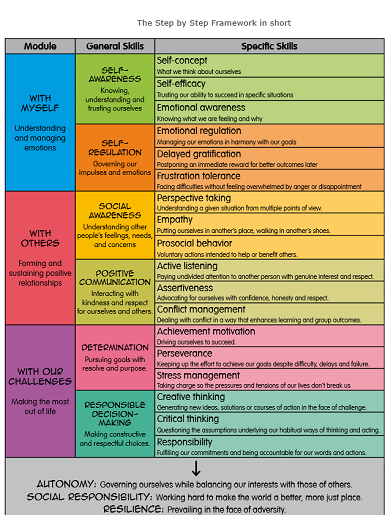The Step by Step toolkit was developed by the World Bank with external contributors to equip teachers with resources that can help their students better understand and manage their emotions, thoughts, impulses and behaviors, form and sustain positive relationships, and make the most out of life by making responsible decisions and pursuing meaningful goals.
The Step by Step framework focuses on six core life skills for children ages 6 through 17: self-awareness, self-regulation, social awareness, positive communication, determination, and responsible decision-making.
These skills further equip children and teens with the tools they need to become engaged, caring, and resourceful members of their communities (socially responsible), govern themselves while balancing their interests with those of others (autonomous), and prevail in the face of adversity (resilient).

The Step by Step toolkit offers a series of practical lessons and support materials designed to be implemented in the classroom by the teacher. Lessons are based on a carefully chosen developmental perspective of middle childhood and adolescence, to fit the characteristics and needs of each age group or grade, from ages 6 through 17.
What’s in the Toolkit?
In this Toolkit teachers will find:
· Teacher Materials: A guide with structured lessons, a list of materials needed to implement each lesson, key concepts, tips for teachers and parents, and answers to frequently asked questions.
· Student Materials: A workbook for each student with illustrated worksheets to use as part of the lessons.
· Classroom Materials (in Spanish only): Posters that will aid in social and emotional learning, as well as children’s storybooks and a CD with songs for primary school.

What are the pedagogical principles behind the Step by Step toolkit design?
Inspired by many successful programs worldwide, the Step by Step toolkit applies the most effective practices for social and emotional education, which guide students through a well-sequenced series of engaging activities focused on the development of specific skills. This approach is known as “SAFE”:
- Sequenced set of activities that are developmentally appropriate for the students in each grade to achieve the learning goals.
- Active forms of learning that focus on experiencing and practicing the skills (e.g., dramatization, role playing, modeling, etc.).
- Focused every week on developing the skills as part of school curricula and during school hours.
- Explicit teaching and learning of a set of social and emotional skills, naming them and showing students how to put them into practice.
What are the keys for implementing it successfully?
The lessons have been designed to last about 45-50 minutes each. A Step by Step teacher/facilitator must be able to foster a healthy, safe, and nurturing learning environment. For that to happen, the teacher must build a genuine relationship with students based on appreciation, respect, unconditional acceptance, protection, and empathy.
Successful Step by Step facilitator:
- Is motivated and enjoys sharing this kind of activities with his students.
- Listens and communicates in a respectful, empathic, assertive, and friendly way.
- Recognizes and values the individual experience of each student.
- Fosters communication and open dialogue to ensure a meaningful learning experience.
- Works hard to avoid reproducing prejudices, stereotypes, or discriminatory attitudes, i.e., reflects and works to overcome his own limitations.
THREE KEYS for Successful Step by Step Experience:
- Prioritize listening over lecturing
- Focus on the students’ experiences, rather than the teacher’s expertise
- Build relationships with the students, rather than concepts and theory
RESOURCES
Key Concepts | Checklist | Objectives |